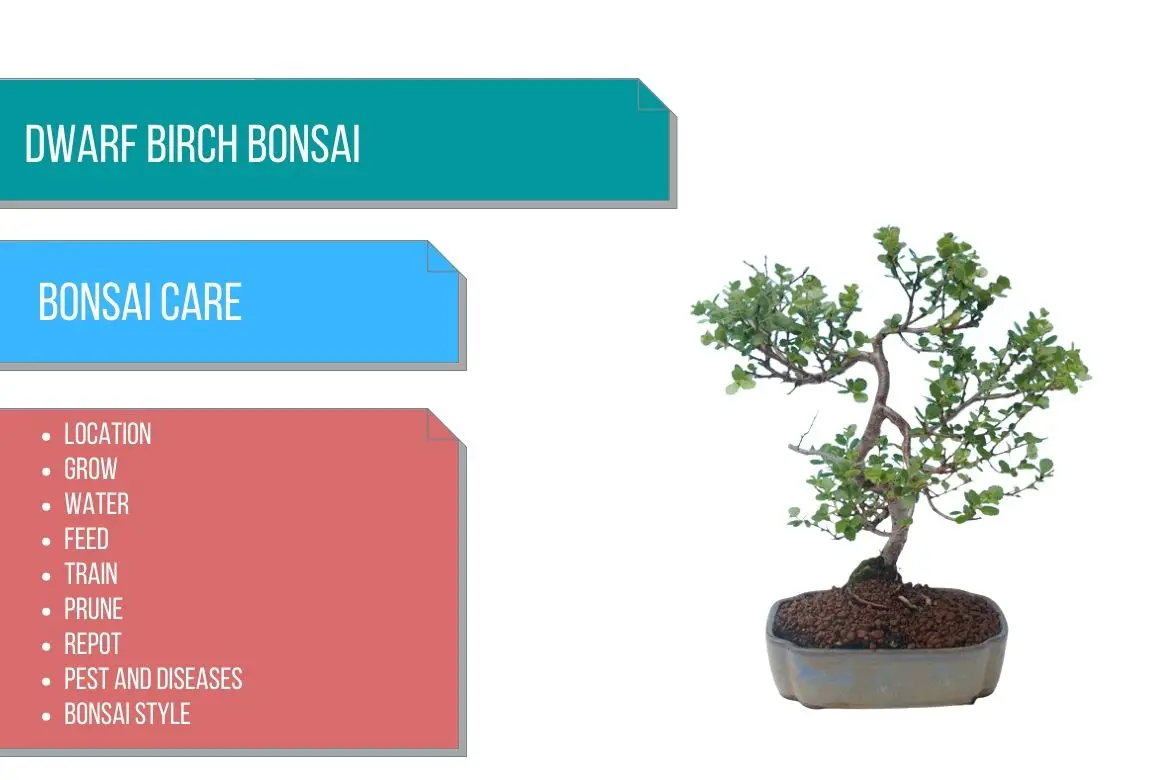
Dwarf Birch
(Betula nana)
Country of Origin : Canada, Northern Europe, Siberia
Bonsai Styles : Informal upright, Slanting, broom, root-over-rock, clasped-to- rock, twin-trunk, clump
Zone : 2 – 6
Most of the care instructions for birch bonsai tree, apply to dwarf birch bonsai. However, there are certain features dwarf birch provides which the regular birch bonsai tree can not. (except for the obvious dwarf nature)
Northern temperate regions are home to the dwarf birch. It is also a deciduous tree.
As it survives the extreme conditions found from Scotland up to the Arctic Circle, it is also known as the Arctic birch. It grows even in mountainous areas close to glaciers, where trees stay snow- and ice-free for only three months of the year.
When clipped properly, it makes for an attractive bonsai with a compact shape.
In order to maintain compact foliage masses, tight pruning is essential when making dwarf bonsai.
It won’t develop the white trunk which a European white birch develops.
However, its trunk has a beauty of its own. It develops a shiny dark copper-colored trunk.
The tiny delicate leaves of the tree turn rich golden in color in winter giving the bonsai tree a particular decorative effect. It has round to oval scalloped leaves.
Unlike, regular sized birch trees, this dwarf version is suitable for small and extra-small bonsai tree specimens and also gives more options of bonsai styles. Furthermore, it is a very useful plant for planting saikei.
Read more about other bonsai trees species in : Bonsai tree care

Best location to keep Dwarf Birch Bonsai
Dwarf Birch bonsai tree is NOT a good bonsai for keeping indoors.
It can be placed in full sun or partial shade. Partial shade from direct sunlight in hot days.
The better the sunlight exposure, the better the deep yellow color of the foliage.
As stated earlier, it has high cold tolerance. However, prevent twig die-back by protecting them from frost.
Place the tree in a location with full sunlight or partial shade. Make sure that the location is dry.
IMP: Refer sunlight requirements for indoor plants for more indoor gardening ideas. Also, refer to do bonsai trees need sunlight for more indoor and outdoor bonsai location ideas.
Propagation of Dwarf Birch
Dwarf birch tree can be propagated by using softwood cuttings.
Take the cuttings in summer and spring. The cuttings of this variety of birch root relatively easily.
They can also be propagated by sowing seeds in winter. Optimum temperature for seed germination is 59°F to 86°F (15°C to 30°C).
Watering Dwarf Birch Bonsai
During the growing season, it should be watered daily, but sparingly during the winter months.
In winter, it is important to keep the soil moist, but do not allow it to dry out.
Read watering bonsai tree for more details.
Wiring Dwarf Birch Bonsai
Wiring is mostly not needed for training this tree.
Pruning Dwarf Birch Bonsai
When to prune Dwarf Birch bonsai?
How to prune Dwarf Birch bonsai?
In order to create dense foliage masses, new shoots should be constantly pruned back to one or two leaves to keep them compact.
During the winter, while the tree is leafless, prune out crossing branches and tidy up the shape of the tree.
Removing of branches will also promote thickness of the trunk.
Repotting Dwarf Birch Bonsai
When to repot dwarf Birch bonsai?
Dwarf birch bonsai can be repoted every 2 years. It can be done in spring.
In case you are repotting before the beds open, then do not perform root pruning. However, if you are doing the repotting after the buds have open then you can do some root pruning. (about 1/4th of the total roots).
You can use a basic free-draining bonsai soil mix as a potting soil. Preferred soil pH is pH 4.9 to 6.5.
OR
Use a soil mix with sand, peat moss and loam at the ratio of 1:1:1.
OR you can use akadama or a mix of organic compost and grit (3:2).
Must Read: Bonsai Soil Recipes
Must read : Choosing the right bonsai container
Feeding Dwarf Birch Bonsai
The bonsai should not be fertilized until one month after the leaves have opened.
After that, apply a balanced feed every two weeks for the duration of the growing season.
Read more about bonsai fertilizer and its application.
Diseases and pest of Dwarf Birch Bonsai
Unlike other birch varieties, betula nana bonsai is pretty pest free and disease resistant.
Dwarf Birch bonsai care
This tree does not respond well to water logging. Decrease in foliage or even death of the plant can be seen in such cases. Hence make sure that the soil is free draining and the container drainage holes are not blocked.

